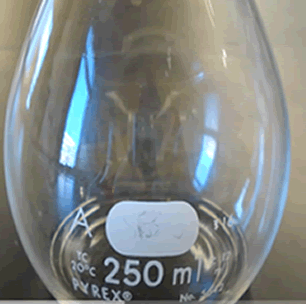Volumetric analysis involves measuring an accurate volume of solution of either known or unknown concentration.
A pipette is used to deliver a very accurate, known quantity of solution depending on its size. For example if a 10 mL sample of solution is required then a 10 mL pipette is used. This instrument is often used to deliver accurate volumes of unknown samples of solution.
The pipette is filled to the mark, pointed to by the arrow.
When emptying the pipette the tip is held so that it makes contact with the edge of the conical flask and the volume is allowed to drain out. A small volume of solution remains at the tip. This is normal and the pipette is calibrated to take this into account so do not attempt to empty this remaining volume into the flask.

A volumetric flask is used when dealing with larger volumes. This occurs when a sample is diluted or when a standard solution is made from a primary standard. in both situations an accurate known volume is required.
Step 1 - an accurate volume of an unknown solution is placed into the volumetric flask using a pipette.
Step 2 - the flask is then filled with distilled water or any other appropriate solvent. Water can be poured into the flask using a distilled water bottle.
Step 3 - when the meniscus approaches close to the mark on the neck of the flask a dropper is used to deliver smaller, more accurate quantities of solvent until the bottom of the meniscus is in line with the mark.

A burette is used to deliver an accurate variable volume. It is used to measure the exact volume of a standard solution required to completely react with a given volume of unknown sample. It can be read to two decimal places and always at eye level with the bottom of the meniscus of the titrant (solution in the burette).
Note -before a titration procedure the pipette and burette are rinsed with the solution that will be placed into each apparatus. The volumetric flask may be washed with distilled water.